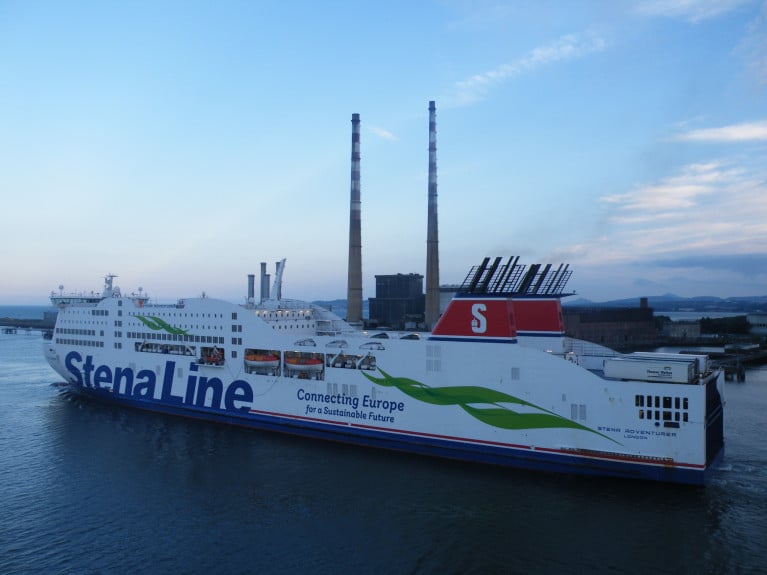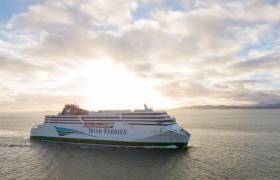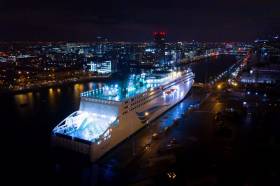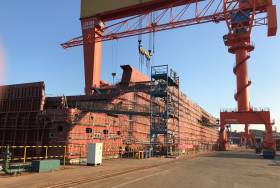Displaying items by tag: DublinHolyhead
ICG Charter Ship from Mediterranean for Irish Ferries Overhaul Dry-Dockings
Irish Continental Group has chartered a ship from Corsica Ferries, to provide routine annual overhaul cover over the winter season for their division Irish Ferries, writes Jehan Ashmore.
Mega Express Four during its Mediterranean Sea career had been normally on France-Corsica routes among them out of Nice, however, Afloat tracked the ferry off Portugal during its repositioning voyage from Vado Ligure close to Savona, Italy.
This morning Mega Express Four had completed the repositioning voyage in Holyhead so to enable berthing trials. The ferry is to depart the north Wales port for Dublin from where it is to arrive tomorrow for further trials and remain in port during the weekend.
According to the Irish Ferries website, Mega Express Four will take up Dublin-Holyhead service next Monday. Ulysses will not operate on two sailings next Monday and is expected to go off service from the Ireland-Wales route and head for dry-docking.
The chartered ferry built-in 1995 as Superfast II, first-served Superfast Ferries on Greece-Italy routes. Originally, there were 12 custom-built ships with the 'Superfast' naming theme, though of varying naval architect designs. Some ships served in northern Europe.
Mega Express Four also operated for new owners on Australian waters linking Tasmania before returning to Europe in 2006 for the current Corsican based operator.
When Mega Express Four enters service, this will be the fifth 'Superfast' ferry to operate from the island of Ireland as a pair of Stena sisters, retaining in part their original name, Stena Superfast's VII/VIII that link the Belfast-Cairnryan route.
Superfast V became Brittany Ferries Cape Finistere recently introduced initially on both Rosslare routes to Cherbourg and Spain, until Connemara took charge of connecting the French port this month.
The fifth 'Superfast' named ferry to run on the Irish waters was the Stena Superfast X, which in recent years departed the Dublin-Holyhead route to began a new career in the Mediterranean and coincidentally running for a rival operator of Corsica Ferries.
In addition the arrival of the chartered ferry sees the Dublin-Holyhead timetable include W.B. Yeats after a final round trip this weekend on the Dublin-Cherbourg route takes place. The largest vessel in the fleet having begun four months earlier than scheduled on the Ireland-France link in response to boosting Brexit-Bypass freight demand.
When W.B. Yeats resumes service on the shorter Irish Sea route, Epsilon will directly take over crossings on the Dublin-Cherbourg route with a sailing taking place also on Monday.
It will be interesting to see if the Mega Express Four is deployed beyond the Irish Sea and possibly cover the route to mainland Europe.
As of today (Friday, 12 Feb) Afloat observed this morning the newcomer pass the Baily Lighthouse in Dublin Bay bound for the port.
While the final survivor of the original 12 ships, Superfast XI still operates for the same operator as the vessel runs between Patras-Igoumenitsa and Ancona. Though the Athens based ferry firm has other secondhand ships serving under the same naming theme.
Ferry Firm Stena Marks 25 Years of Dublin-Holyhead Service
Ferry operator Stena Line celebrates today the 25th anniversary of its Dublin Port-Holyhead service – a quarter of a century that has seen the company carry in excess of 12 million passengers, almost 3 million cars and 3.5 million freight units on the route.
In 1995 the company traded as Stena Sealink with the first vessel to sail on the new Ireland-Wales service the Stena Traveller.
The route today is operated by the Stena Adventurer and the recently-built Stena Estrid, the first of three ‘next generation’ ferries commissioned for the Irish Sea, accommodating a mix of freight and leisure traffic.
Over the last 25 years, Stena Line has invested significantly in the Dublin to Holyhead route as volumes have increased significantly both in freight and leisure travel numbers. In fact, if all vehicles that have travelled with the operator to and from Dublin Port were laid end to end, they would circle the entire globe.
“The establishment of our Dublin Port-Holyhead operation 25 years ago today has been something of a game changer for us on the Irish Sea,” said Paul Grant, Stena Line Trade Director (Irish Sea).
“Holyhead has been a strategically important commercial gateway between Britain and Ireland for well over a century. Back in 1995 it was clear that Dublin Port was able to offer Stena Line the future expansion opportunities we required to help develop our business potential in the region, and that vision has now been rewarded.
“Today the service is one of Stena Line’s best performing Irish Sea routes which is why it was chosen to receive the first of the company’s three new build ferries, Stena Estrid, in January of this year. At 215 metres in length with a freight capacity of 3 100 lane meters, Stena Estrid also has the space to carry 120 cars and 1,000 passengers,” he added.
“However, no amount of foresight or planning could have factored in the devastating impact of the Covid 19 pandemic, but I am proud of the key role that Stena Line and my colleagues have played in helping to keep vital food and medical supply lines operational between Ireland and Britain throughout this crisis. We have worked hard to keep our guests and colleagues safe throughout this challenging time and are confident that the ferry industry will be one of the first sectors of the tourism sector to see a return to pre-Covid trading, when it is deemed safe to do so.
“As we move into 2021, Brexit will also provide a challenge for our business as it will for many others. We have been engaging constructively with authorities on both sides of the Irish Sea to ensure the free flow of goods through our ports and are assisting our freight customers as much as we can in their regulatory preparations for Brexit.
“As for the next 25 years, we have set a firm course on becoming the most sustainable global ferry operator, and I’m confident we have the vision and talent to achieve this ambition,” concluded Mr Grant.
Ferries Old & New Swap Stena Sailing Rosters for Annual Dry-Docking
The longest serving Dublin-Holyhead ferry operated by Stena Line departed the Irish capital this morning bound for Falmouth in the UK to undergo annual dry-docking, writes Jehan Ashmore.
Stena Adventurer built in South Korea was launched onto the Irish Sea central corridor route in 2003, is to dry-dock at A&P Falmouth, Cornwall and where a refit of some passenger facilities is also to take place. This is to update passenger facilities among them a 'Hygge' Lounge, a feature on board the new Stena Estrid, the operator's first E-Flexer ropax class built in China which last month entered service.
Taking over the sailing roster of Stena Adventurer is the Stena Estrid. As for newbuild's own roster this in turn is to be covered by Stena Superfast X, which transpires has made a return to its former Irish Sea route to maintain a two-ship service. This follows a stint on the Rosslare-Cherbourg route as Afloat previously reported.
Prior to the Superfast X return to the Ireland-Wales route, a repositioning passage saw the German built ferry depart the Wexford port and arrive at Anglesey yesterday. On Monday, the Ireland-France route's routine ropax ferry Stena Horizon returned from A&P Falmouth having completed a planned dry-docking.
Afloat yesterday evening tracked Stena Adventurer enter Dublin Port following a non commercial sailing from Holyhead, as the ferry did not berth at the ferryport Terminal 2 but instead headed upriver to Ocean Pier, Alexandra Basin East.
According to an Afloat source, Stena Adventurer berthed in the Basin for a Marine Survey Office (MSO) audit. At the same time this allowed relief ferry Stena Superfast X to berth at the nearby ferryport's No. 51 berth, before the 'Adventurer' departed for dry-docking.
The Stena Adventurer remained in Alexandra Basin overnight before departing this morning. The 210m long ferry is expected to arrive at Falmouth tomorrow morning and enter A&P Falmouth's Dry-Dock No.2.
Minister Ross Under Fire for Leaving it Late to Outline Ports' Brexit Contingency Plans
#irishports - The Minister for Transport Shane Ross writes Independent.ie is under fire over the readiness of the country's main ports to cope in the event of a no-deal Brexit.
Documents released to Fianna Fáil's Robert Troy under Freedom of Information show that the Department of Transport, Tourism and Sport (DTTAS) only requested an outline of a contingency plan on November 15 last from Dublin and Rosslare ports.
Concern relating to how a crash-out Brexit would affect Dublin Port in particular is evident in the correspondence. Rosslare was asked if there was capacity for it to help out if Dublin Port runs into delays, while Dublin was asked to outline the potential for problems with trade, traffic and delays.
A deadline of November 23 was given to both ports to return the outline plan - just 18 weeks before Britain's scheduled leave date.
For more on the story including traffic plans to and from the Welsh port of Holyhead click here
W.B. Yeats Makes Maiden Sailing from Dublin to Holyhead
#ferries - W.B. Yeats has finally made its maiden sailing this morning, as the €147m cruiseferry completed a Dublin-Holyhead crossing by arriving in the Welsh port before lunch-hour, writes Jehan Ashmore.
The impressive 1,885 passenger and crew/300 car/165 truck capacity newbuild ordered by ICG, parent company of Irish Ferries, which was beset with delays at the FSG shipyard in Germany, is now the biggest ever ferry to operate on the Irish Sea.
W.B. Yeats berthed in the Anglesea port though around an hour later than scheduled at 12.20 when Afloat tracked the ship dock in the outer port. This took place in advance of the original scheduled inaugural sailing planned for this Friday. In addition neither did 'freight' only sailings commence as scheduled, which were due to have begun more than a week ago.
This afternoon (14.00) the newbuild is to carry more passengers and freight with the first return leg of the route from Wales.
At around, 51,000 gross tonnage, W.B. Yeats will be a significant boost on the core Irish Sea route, which up till now was served primarily by Ulysses, which is due back in service this Thursday following annual dry-docking. In the meantime, ropax Epsilon also operates having been accompanied by Oscar Wilde, which made its final sailing on the route this morning with an arrival to Dublin Port.
In less than two months time, W.B. Yeats which was also built to serve between Ireland and France will operate the Dublin-Cherbourg route by entering service in mid-March.
Sailings on the direct Ireland-mainland Europe route is to take place just over a fortnight before the UK is due to leave the EU on the 29 March. With vehicle deck space for 2,800 freight lane metres, W.B. Yeats will be vital asset to ensure direct trade links for hauliers with an alternative of the UK landbridge and in whatever Brexit scenario arises.
As for passenger facilities, among them is the the Maud Gonne Bar & Lounge, Innisfree Club Class Lounge, The Hazel Wood Quiet Lounge and The Abbey & The Peacock Cinema & Lounge.
Accommodation comprises 440 cabins and of the luxury suites they feature a balcony along with a dedicated butler service. This feature will be particularly suited for the longer sea journey between the Irish capital and Normandy.
W.B. Yeats Maiden 'Freight' Sailing Re-Scheduled to Next Week On Tuesday
#ferries - W.B. Yeats maiden sailing as previously reported on Afloat.ie has changed date according to the Irish Ferries freight website, though the rescheduled sailing remains based on a freight-only basis, writes Jehan Ashmore.
Orginally, the first sailing was due to depart from Dublin tonight, however the inaugural sailing on the Irish Sea is instead scheduled for this Tuesday, (January 15th). This is to take place in the morning with the 08.05 sailing bound for Holyhead, Wales.
Further research has revealed albeit on the operator's passenger website, that at the same time W.B. Yeats maiden sailing departs the Irish capital, Oscar Wilde with a 1,450 passenger capacity, is also to leave then and operate to a full service. Sailings taking passengers too, Irish Ferries has confirmed to Afloat, will see W.B. Yeats start such services on January 25th.
As for this Tuesday's sailings, both W.B. Yeats and Oscar Wilde are scheduled to arrive in the Anglesey port just 10 minutes apart with the brand new €147m cruiseferry to arrive first with a docking time scheduled for 11.20. Passengers on board Oscar Wilde will also be able to get close-up views of the new 51,000 gross tonnage cruiseferry when in Holyhead's outer ferryport.
Another change next week on the core Ireland-UK landbridge route involves Ulysses, the route's main cruiseferry since 2001, which is to go off service for routine annual dry-docking.
In addition ro-pax Epsilon which underwent dry-docking, is to resume sailings also on Tuesday, though today the chartered-in ferry with limited passenger capacity, is docked in Cherbourg.
Due to conducting dry-docking in Brest, Brittany, Epsilon has recently made a repositioning passage to Normandy so to enable offering a sailing tonight from the French port to Dublin, where the vessel is due to arrive tomorrow morning.
Otherwise sailings on the direct Ireland-France routes have been almost non-existent of recent months, however this is all about to change with the debut of W.B. Yeats from mid-March.
As for Rosslare based routes connecting Cherbourg and Roscoff, Irish Ferries last month announced they are unlikely to operate such services between the Wexford port and France this year. The operator added that they will continue to keep this situation under review and stated W.B. Yeats will operate from Dublin to Cherbourg up to 4 days per week.
New Freight Record Set By Stena Line on Its Dublin-Holyhead Service
#DublinPort - A major operator in Dublin Port, Stena Line has set a new company record for freight on its service to Holyhead, carrying a total of over 250,000 units in 2018.
The milestone was achieved today, when Patrick van der Vijver from Hannon Transport completed the 08.10 hrs crossing from Dublin to Holyhead.
Patrick had the honour of transporting the freight unit on the Stena Adventurer. To celebrate the record-breaking achievement on the Irish Sea, he was presented with a bottle of champagne and free car + 2 crossing on the route by Stena Line’s Onboard Services Receptionist Rob Owen and Onboard Services Manager Sharon Kelly as pictured above.
Ian Davies, Stena Line Trade Director (Irish Sea South) said: “Achieving over a quarter of a million freight units on our Dublin-Holyhead service is a major business achievement for our region. Dublin – Holyhead is a crucial trading link between Ireland and Britain as evidenced by this record volume of freight traffic in 2018. Stena Line has worked hard over the last number of years to develop this service".
"We have striven to improve service levels, reliability and punctuality, working with our valued freight customers to optimise our respective businesses. We are also investing in the future with the Dublin – Holyhead route being chosen by Stena Line as the first European route to take delivery of the first of its new generation ferries, current under construction, in early 2020. Crucially, the new vessel will offer over 3 000 lane meters of freight capacity, a 50% increase on the vessel it will take over from.”
The company is the largest ferry operator on the Irish Sea, running services between Ireland and the UK in addition to Ireland and France, that together total 238 weekly sailings.
W.B. Yeats Maiden Commercial Sailing Scheduled A Month After Christmas But On Dublin-Holyhead Route
#FerryNews - According to the Irish Ferries website, online bookings for W.B. Yeats, indicate that the brand new €144m luxury cruiseferry is to enter service a month after Christmas Day, but firstly on the Dublin-Holyhead route, writes Jehan Ashmore.
Afloat has identified that the maiden commercial crossing of W.B. Yeats, the 1,800 passenger/1,200 vehicles, is to take place between Ireland and Wales next year, with a sailing scheduled on 25 January.
The timing for the maiden crossing, was echoed on the ferry's facebook page in regards to a query, if the new ship will be open to the public in advance of service, however Irish Ferries responded that there will be no public open days but that sailings on the Dublin-Holyhead route from January will be available.
The 54,000 gross tonnage newbuild currently docked next to Dublin's East-Link bridge, was to have orginally entered on the route to Wales in September, following the debut of the W.B. Yeats on the Dublin-Cherbourg route this summer. As well documentated at this stage, delays caused by contractors supplying the German shipyard prevented such plans.
Irish Ferries recenty revealed a revised date to launch W.B. Yeats on the Dublin-Cherbourg route that is to begin in mid-March, though the operator this week accounced Rosslare-based routes to French ports of Cherbourg and Roscoff are unlikely to resume in 2019.
The decision to withdrew the direct routes to mainland Europe, drew widespread critism from the public, the haulage sector and policitians alike. Irish Ferries however stated that they will continue to keep this situation under review.
In the meantime in the run up to the busy festive period, Irish Ferries have both Ulysses and Oscar Wilde maintaining services on the Dublin-Holyhead route.
The chartered in ropax Epsilon, will continue operating on the year-round operated Dublin-Cherbourg route. It is still possible to sail from Rosslare-Cherbourg before the year ends, given Wexford based sailings to France ceased in recent months. For example Afloat has also identified a sailing from Rosslare to Cherbourg on 29 December.
On the Rosslare-Pembroke route, Isle of Inishmore will operate too up to the festive period on the route linking south Wales.
As usual there will be no sailings operated during Christmas Day and St. Stephen's Day.
Also according to the operator's booking site, Ulysses is to take a final crossing from Dublin to Holyhead on 6 January, this would suggest an off-service period for routine dry-docking.
During the months of January and February, been the quietest time, it is routine for ferry operators to dry-dock ferries for annual dry-docking maintenance.
For the latest information on all routes, sailings and updates, it is advisable to consult the operator's website here.
All Three New Irish Sea Stena E-Flexers On Schedule and Under Construction in China
#Ferry - Ferry operator Stena Line has reached an important milestone in its major new fleet investment programme with steel-cutting of a third E-Flexer RoPax ship to be deployed on its Irish Sea routes.
This means that all three of Stena Line’s new E-Flexer ships, planned to enter into service on the Irish Sea during 2020 and 2021, are now under construction at the Avic Weihai Shipyard in China.
The first of the new vessels will commence operation on the Holyhead to Dublin route in early 2020, with the remaining two ships to be introduced on the Liverpool to Belfast route in 2020 and 2021.
Stena Line Chief Operating Officer Peter Arvidsson commented: “We are delighted to report that the steel cutting ceremony for the third of our Irish Sea E-Flexer ships has now taken place and that construction is going to plan across all three of our new generation RoPax vessels. Having visited the site several times, we are very impressed with the work being carried out by Stena RoRo, the Avic shipyard and its subcontractors.”
All three Irish Sea E-Flexer vessels will be bigger than today’s standard RoPax vessels at 215 meters long with a freight capacity of 3,100 lane meters and the space to carry 120 cars and 1,000 passengers.
In addition, Stena Line has also ordered a further two E-Flexer RoPax vessels with a larger design, to be deployed within Stena Line’s network in 2022. These larger ships will be 240 meters long with a total freight capacity of 3,600 lane meters, and passenger capacity of 1,200.
“With continued investment in our fleet, we want to lead the development of sustainable shipping and set new industry standards when it comes to operational performance, emissions and cost competiveness,” added Mr Arvidsson.
Stena Line is the largest ferry operator on the Irish Sea, offering the biggest fleet and the widest choice of routes between Britain and Ireland including Liverpool to Belfast, Heysham to Belfast, Cairnryan to Belfast, Holyhead to Dublin and Fishguard to Rosslare, a total of 232 weekly sailings. The company also offers a direct service from Rosslare to Cherbourg with three return crossings a week.
Internationally, Stena Line is one of Europe’s leading ferry companies with 38 vessels and 21 routes in Northern Europe.
The company is an important part of the European logistics network and develops new intermodal freight solutions by combining transport by rail, road and sea.
Stena Line also plays an important role for tourism in Europe with its extensive passenger operations.
The company is family-owned, was founded in 1962 and is headquartered in Gothenburg.
Stena Line is part of the Stena AB Group, which has about 15 000 employees and an annual turnover of around 36.5 billion SEK.
Ulysses Out of Service Again On Dublin-Holyhead Route
#FerryNews - Ulysses, flagship of Irish Ferries which was forced out of service for over a month during the peak season is once again not operating on the Holyhead route having docked in Dublin Port last night, writes Jehan Ashmore.
The company had cited a 'technical reason' though it is understood this incident it is not a repeat of the summer's problems with the starboard controllable pitch propeller which took place on 24th June. This led to the 50,938 gross tonnage flagship having to undergo major repairs in Harland & Wolff, Belfast. Otherwise the custom-built cruiseferry has had a strong reliability record since introduction in 2001.
Ulysses having completed a round trip to Holyhead, yesterday evening proceeded upriver to berth in Alexandra Basin. It would appear that the off service situation is short-term, given that the Ulysses is scheduled to return to service this Wednesday (1st November) on the 20:55 sailing to Holyhead. Check here for updates.
In the meantime while Ulysses remains in Alexandra Basin, this is also where earlier this month, the route's Holyhead newly introduced fast-ferry craft Dublin Swift had problems too. Work was carried out that enabled a return to the route just days before it ended a first 'seasonal' service previously operated by Jonathan Swift. The winter layover in the port of the larger and newer fast-craft is to end with resumption of sailings in Spring 2019.
Currently, taking place of Ulysses sailing roster is Isle of Inishmore, where Afloat noted a repositioning passage from Rosslare which saw an arrival yesterday morning to Dublin Port. The Isle of Inishmore is no stranger on the Dublin route having also been custom-built in 1997 to serve the north Wales route when ordered by the operator's parent company ICG.
Also operating on the Wales route but routinely is ropax Epsilon, however a third ferry was also in service until Sunday night, Oscar Wilde that provided additional sailings since earlier this month. The cruiseferry also served direct Dublin-Cherbourg crossings, however in the early hours of yesterday morning made a repositioning passage to Rosslare to take over the 'Inishmore' roster that began with a morning crossing to Pembroke.
On a related note to Ireland-France services, Afloat will have more to report on the much delayed €150m cruiseferry W.B. Yeats that was to have made a debut on the Dublin route last July followed by a transfer to Holyhead from September but only for the winter. During that time Epsilon would maintain the year-round operated route given no Rosslare based sailings.



































































